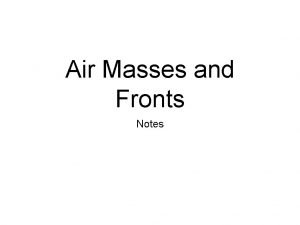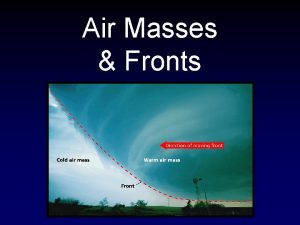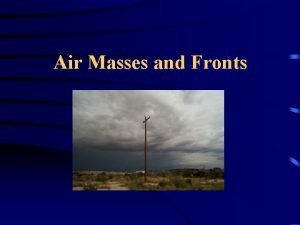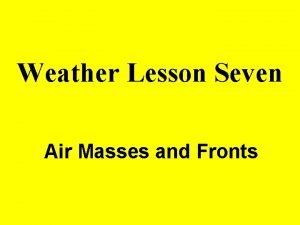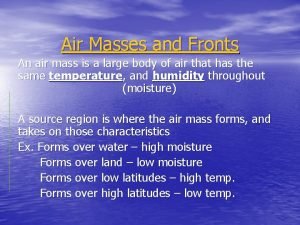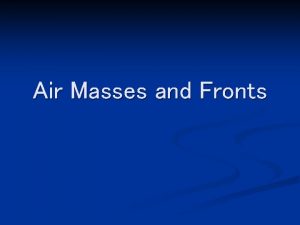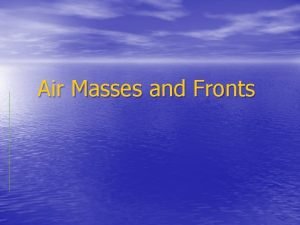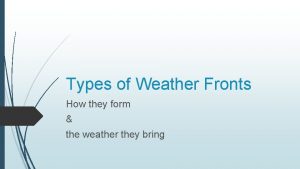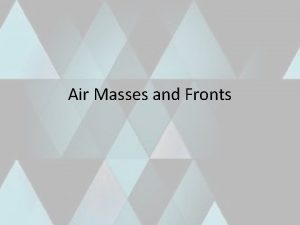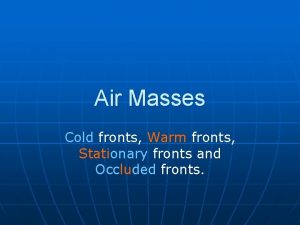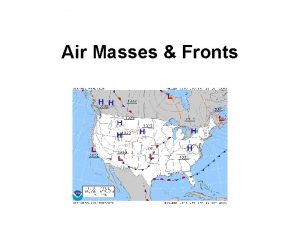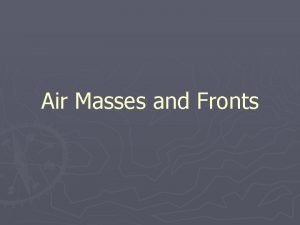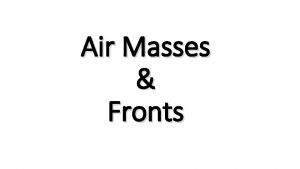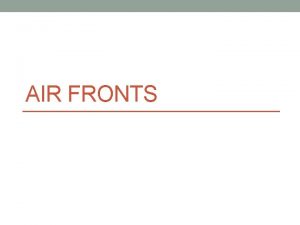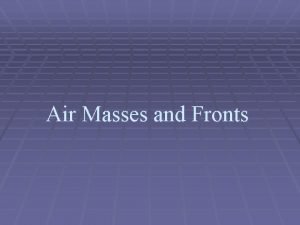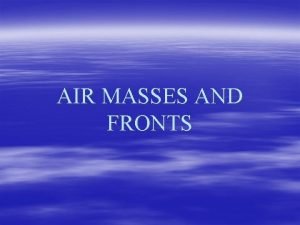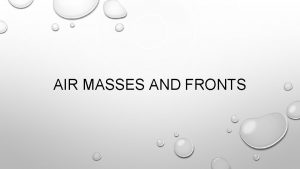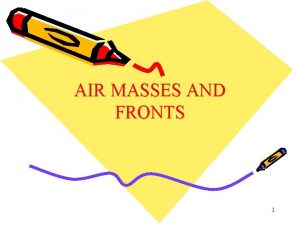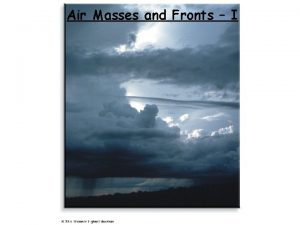Air Masses and Fronts Air Mass An air














- Slides: 14

Air Masses and Fronts

• Air Mass: – An air mass is a huge body of air that has similar temperature, humidity, and air pressure at any given height. – Air masses are classified by 2 characteristics 1. Temperature 2. Humidity – The characteristics of an air mass depend on the temperatures and moisture content of the region over which the air mass formed. • • Tropical: warm, air masses formed in the tropics Polar: cold, air masses form near north or south pole Maritime: air masses formed on oceans or seas Continental: air masses formed over land

– The colder the air the higher the air pressure subsequently the hotter the air the lower the air pressure. • • Cold air more dense Hot air less dense – There are 4 major types of air masses that affect the weather of the U. S. 1. 2. 3. 4. Maritime tropical Maritime polar Continental tropical Continental polar

1. Maritime tropical – Warm, wet air masses – On the east coast they are formed over the Gulf of Mexico & south Atlantic Ocean. – Influence weather along the entire east coast. – Summer: thunderstorms & summer showers – Winter: heavy snow or rain – On the west coast they form over the southern Pacific Ocean.

2. Maritime polar – – – Cold, wet air masses On the east coast they are formed over the north Atlantic Ocean. On the west coast they are formed over the north Pacific Ocean. – Influence the weather of the west coast more so than that of the east coast. – Summer/Winter: fog, rain, & cooler temperatures

3. Continental tropical – – Warm, dry air masses Typically form over the southwest (New Mexico, Arizona, Nevada, as well as northern Mexico) during the summer months. – Influence the weather of the southwestern part of the US & southern Great Plains (Kansas, Oklahoma, Texas, Iowa). – Summer: Hot, dry

4. Continental polar – Cold, dry air masses – Typically form over central & northern Canada as well as Alaska. – Influence the weather of the entire United States. – Winter: Clear, cold, dry – Summer: Potential for storms due to interaction with Maritime tropical air moving up from the Gulf of Mexico.

• 2 primary methods for air mass movement 1. Prevailing Westerlies – Pushes air masses from west to east. 2. Jet streams – Pushes fast moving air masses from west to east.

Fronts – The boundary between two air masses. • Air masses do not easily mix with each other due to the differences in… – Density (Air pressure) – Temperature – Moisture content • Storms & different types of weather phenomena occur along fronts.

Fronts 1. Cold front – Fast moving cold air mass overtakes a slower moving warm air mass. – Can cause abrupt weather changes particularly thunderstorms. – Clear skies, a change in wind, & lower temperatures usually follow a cold front. – http: //www. youtube. com/watch? v=Xc. HHi ULyr. PY

2. Warm front – A fast moving warm air mass overtakes a slow moving cold air mass. – Can cause extended periods of rainy or cloudy weather. – Warm, humid weather usually follows a warm front. – http: //www. youtube. com/watch? v=hu. K YKykjcm 0&feature=related

3. Stationary front – A cold and warm air mass meet but neither can move the other. – Can cause extended periods of precipitation; snow, rain, fog or clouds. 4. Occluded front – A warm air mass is caught between 2 cooler air masses. – http: //www. phschool. com/atschool/phsciexp /active_art/weather_fronts/

Cyclones (Greek for “wheel”) – Formed around centers of low pressure. – Caused as the boundary between fronts become distorted by surface features; mountains or strong winds. – Represented on weather maps by an L. – Warm air rises and spins counterclockwise around the center. – Storms and precipitation are associated with areas of low pressure.

Anticyclones – Formed around centers of high pressure. – Represented on weather maps by an H. – Cold air sinks and spins clockwise around the center. – Dry weather and clear skies are associated with areas of high pressure.
 Mt air mass
Mt air mass Types of air masses
Types of air masses Air masses in north america
Air masses in north america Why are cold fronts steeper than warm fronts
Why are cold fronts steeper than warm fronts Two cold air masses converge on a warm air mass
Two cold air masses converge on a warm air mass Air masses & frontswhat is an air mass?
Air masses & frontswhat is an air mass? Air masses & frontswhat is an air mass?
Air masses & frontswhat is an air mass? The boundary between two adjacent air masses is called
The boundary between two adjacent air masses is called Air masses & frontswhat is an air mass?
Air masses & frontswhat is an air mass? Air masses & frontswhat is an air mass?
Air masses & frontswhat is an air mass? Air masses & frontswhat is an air mass?
Air masses & frontswhat is an air mass? Cold air mass overtakes warm air mass
Cold air mass overtakes warm air mass A swirling center of low air pressure is called
A swirling center of low air pressure is called Cold front
Cold front Types of air masses
Types of air masses

